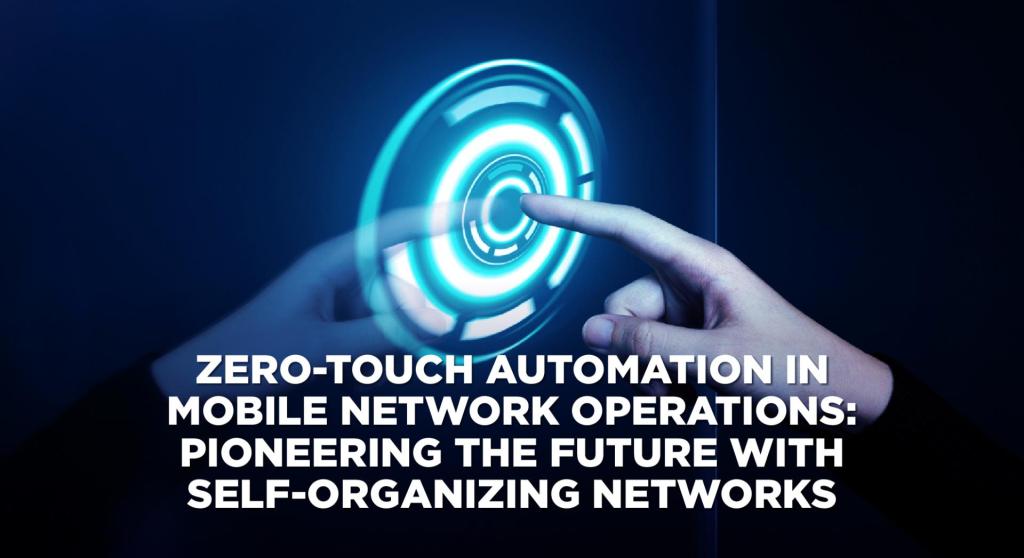Introduction
The telecommunications industry is experiencing an unprecedented evolution, driven by the demands of 5G, IoT, and the increasing need for ultra-reliable, low-latency communication. In this dynamic landscape, the complexity of mobile networks has surged, necessitating more efficient and intelligent operational paradigms. Zero-touch automation emerges as a transformative solution, enabling seamless network operations with minimal human intervention. At the core of this paradigm lies Self-Organizing Networks (SON), a foundational technology that automates key processes in mobile network management. This article explores the synergy between zero-touch automation and SON, their enabling technologies, use cases, and their transformative potential for mobile network operators (MNOs).
Understanding Zero-Touch Automation
Definition and Scope
Zero-touch automation refers to implementing fully autonomous operational processes within a network, reducing or eliminating the need for manual intervention. It leverages advanced technologies such as AI, ML, and intent-based frameworks to configure, optimize, and manage networks dynamically. This approach is particularly relevant in 5G networks, where the volume of devices and network slices necessitates scalable and intelligent operations.
Relevance in Modern Networks
Modern mobile networks face challenges like growing data traffic, increased device density, and stringent service-level agreements (SLAs). Zero-touch automation addresses these challenges by ensuring the following:
Scalability: Autonomous processes handle network growth efficiently.
Operational Efficiency: AI-driven insights reduce time and costs associated with manual configurations.
Customer Experience: Improved network quality and reliability enhance end-user satisfaction.
The Role of Self-Organizing Networks (SON)
What is a Self-Organizing Network?
Self-organizing networks (SON) are intelligent systems designed to automate and optimize mobile network operations. They perform three primary functions:
Self-Configuration: Automating the deployment of new network elements.
Self-Optimization: Dynamically adjusting network parameters for optimal performance.
Self-Healing: Identifying and resolving faults autonomously.

Core Functions of SON
Automatic Network Configuration: Simplifies integrating new base stations or cells into the network.
Performance Optimization: Enhances throughput, coverage, and capacity through real-time adjustments.
Fault Management and Healing: Detects anomalies and rectifies them without human intervention.
SON as a Foundation for Automation
SON’s modular architecture serves as a cornerstone for zero-touch automation. Its ability to integrate AI and ML for real-time decision-making enables networks to operate efficiently with minimal manual oversight. Real-world deployments demonstrate SON’s ability to optimize resource allocation, balance traffic loads, and enhance network resilience.
The Synergy Between SON and Zero-Touch Automation
Interlinking Concepts
Zero-touch automation extends the principles of SON by enabling intent-based operations where high-level goals are translated into automated tasks. SON modules, such as Mobility Robustness Optimization and Coverage Optimization, align perfectly with the objectives of zero-touch automation, providing:

Core Functions of SON
Automatic Network Configuration: Simplifies integrating new base stations or cells into the network.
Performance Optimization: Enhances throughput, coverage, and capacity through real-time adjustments.
Fault Management and Healing: Detects anomalies and rectifies them without human intervention.
SON as a Foundation for Automation
SON’s modular architecture serves as a cornerstone for zero-touch automation. Its ability to integrate AI and ML for real-time decision-making enables networks to operate efficiently with minimal manual oversight.
Real-world deployments demonstrate SON’s ability to optimize resource allocation, balance traffic loads, and enhance network resilience.
The Synergy Between SON and Zero-Touch Automation
Interlinking Concepts
Zero-touch automation extends the principles of SON by enabling intent-based operations where high-level goals are translated into automated tasks. SON modules, such as Mobility Robustness Optimization and Coverage Optimization, align perfectly with the objectives of zero-touch automation, providing:
Real-Time Optimization: AI-powered algorithms adjust network parameters dynamically.
Proactive Fault Management: Predictive analytics identify and resolve issues before they impact users.
Dynamic Resource Allocation: Automated adjustments ensure optimal utilization of spectrum and hardware resources.
Use Cases
Autonomous Network Configuration: SON modules automate parameter settings during new cell deployments, ensuring faster integration and reduced downtime.
Proactive Healing: AI-driven SON systems predict and address faults, minimizing service interruptions.
Traffic Load Balancing: Zero-touch automation, powered by SON, redistributes traffic across cells to prevent congestion.
Benefits of the Synergy
Enhanced Reliability: Automated fault resolution reduces outages.
Operational Efficiency: Minimizes manual interventions, reducing operational expenditure (OPEX).
Scalable Operations: Adapts to network expansion with minimal configuration overhead.
Enabling Technologies for Zero-Touch Automation and SON
Artificial Intelligence and Machine Learning
AI and ML are pivotal in enabling zero-touch automation and enhancing SON capabilities. Their applications include:
Predictive Analytics: Identifying potential faults and optimizing resource allocation.
Intent-Based Networking: Translating high-level business goals into actionable network configurations.
5G and Beyond
The advent of 5G introduces challenges such as network slicing, massive IoT deployments, and ultra-reliable low-latency communication (URLLC). Zero-touch automation, underpinned by SON, addresses these challenges by:
- Managing dynamic network slices efficiently.
- Supporting the deployment of private and hybrid networks.
- Ensuring end-to-end visibility and control.
Cloud-Native Architectures
Cloud-native designs provide the agility and scalability required for zero-touch operations. Cloud integration benefits SON systems by enabling distributed processing, reducing latency, and enhancing real-time decision-making.
Real-Time Optimization: AI-powered algorithms adjust network parameters dynamically.
Proactive Fault Management: Predictive analytics identify and resolve issues before they impact users.
Dynamic Resource Allocation: Automated adjustments ensure optimal utilization of spectrum and hardware resources.
Use Cases
Autonomous Network Configuration: SON modules automate parameter settings during new cell deployments, ensuring faster integration and reduced downtime.
Proactive Healing: AI-driven SON systems predict and address faults, minimizing service interruptions.
Traffic Load Balancing: Zero-touch automation, powered by SON, redistributes traffic across cells to prevent congestion.
Benefits of the Synergy
Enhanced Reliability: Automated fault resolution reduces outages.
Operational Efficiency: Minimizes manual interventions, reducing operational expenditure (OPEX).
Scalable Operations: Adapts to network expansion with minimal configuration overhead.
Challenges in Implementing Zero-Touch Automation
Technical Challenges
Operational Challenges
Innovile’s Contributions to Zero-Touch Automation
Innovile’s INNTELLIGENT platform exemplifies the potential of SON in zero-touch automation. Key capabilities include:
Automatic Performance Reports: Providing actionable insights with minimal delay.
Real-Time Alerts: Enabling proactive responses to network anomalies.
Energy-Saving Modules: Reducing energy consumption through intelligent resource management.
INNSPIRE for Network Configuration
The INNSPIRE platform complements SON by streamlining network planning and configuration. Its features include:
Future of Zero-Touch Automation in Mobile Networks
Towards Autonomous Networks

The ultimate vision for zero-touch automation is the development of fully autonomous networks. These networks, powered by AI and edge computing, will:
- Operate with minimal human oversight.
- Deliver unparalleled reliability and efficiency.
- Adapt dynamically to emerging challenges and technologies.
The Path Ahead
As 6G looms on the horizon, integrating SON with zero-touch automation will become even more critical. Anticipated advancements include AI-powered self-learning systems, enhanced cybersecurity frameworks, and greater interoperability across network domains.
The ultimate vision for zero-touch automation is the development of fully autonomous networks. These networks, powered by AI and edge computing, will:
- Operate with minimal human oversight.
- Deliver unparalleled reliability and efficiency.
- Adapt dynamically to emerging challenges and technologies.

The Path Ahead
As 6G looms on the horizon, integrating SON with zero-touch automation will become even more critical. Anticipated advancements include AI-powered self-learning systems, enhanced cybersecurity frameworks, and greater interoperability across network domains.

